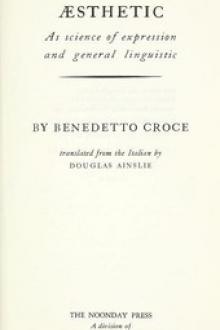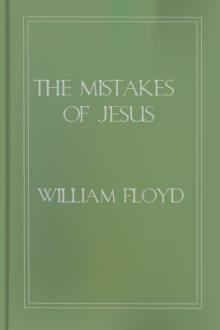The Sense of Beauty, George Santayana [e ink epub reader .txt] 📗

- Author: George Santayana
- Performer: -
Book online «The Sense of Beauty, George Santayana [e ink epub reader .txt] 📗». Author George Santayana
The objects thus conceived and distinguished from our ideas of them, are at first compacted of all the impressions, feelings, and memories, which offer themselves for association and fall within the vortex of the amalgamating imagination. Every sensation we get from a thing is originally treated as one of its qualities. Experiment, however, and the practical need of a simpler conception of the structure of objects lead us gradually to reduce the qualities of the object to a minimum, and to regard most perceptions as an effect of those few qualities upon us. These few primary qualities, like extension which we persist in treating as independently real and as the quality of a substance, are those which suffice to explain the order of our experiences. All the rest, like colour, are relegated to the subjective sphere, as merely effects upon our minds, and apparent or secondary qualities of the object.
But this distinction has only a practical justification. Convenience and economy of thought alone determine what combination of our sensations we shall continue to objectify and treat as the cause of the rest. The right and tendency to be objective is equal in all, since they are all prior to the artifice of thought by which we separate the concept from its materials, the thing from our experiences.
The qualities which we now conceive to belong to real objects are for the moat part images of sight and touch. One of the first classes of effects to be treated as secondary were naturally pleasures and pains, since it could commonly conduce very little to intelligent and successful action to conceive our pleasures and pains as resident in objects. But emotions are essentially capable of objectification, as well as impressions of sense; and one may well believe that a primitive and inexperienced consciousness would rather people the world with ghosts of its own terrors and passions than with projections of those luminous and mathematical concepts which as yet it could hardly have formed.
This animistic and mythological habit of thought still holds its own at the confines of knowledge, where mechanical explanations are not found. In ourselves, where nearness makes observation difficult, in the intricate chaos of animal and human life, we still appeal to the efficacy of will and ideas, as also in the remote night of cosmic and religious problems. But in all the intermediate realm of vulgar day, where mechanical science has made progress, the inclusion of emotional or passionate elements in the concept of the reality would be now an extravagance. Here our idea of things is composed exclusively of perceptual elements, of the ideas of form and of motion.
The beauty of objects, however, forms an exception to this rule. Beauty is an emotional element, a pleasure of ours, which nevertheless we regard as a quality of things. But we are now prepared to understand the nature of this exception. It is the survival of a tendency originally universal to make every effect of a thing upon us a constituent of its conceived nature. The scientific idea of a thing is a great abstraction from the mass of perceptions and reactions which that thing produces the aesthetic idea is less abstract, since it retains the emotional reaction, the pleasure of the perception, as an integral part of the conceived thing.
Nor is it hard to find the ground of this survival in the sense of beauty of an objectification of feeling elsewhere extinct. Most of the pleasures which objects cause are easily distinguished and separated from the perception of the object: the object has to be applied to a particular organ, like the palate, or swallowed like wine, or used and operated upon in some way before the pleasure arises. The cohesion is therefore slight between the pleasure and the other associated elements of sense; the pleasure is separated in time from the perception, or it is localized in a different organ, and consequently is at once recognized as an effect and not as a quality of the object. But when the process of perception itself is pleasant, as it may easily be, when the intellectual operation, by which the elements of sense are associated and projected, and the concept of the form and substance of the thing produced, is naturally delightful, then we have a pleasure intimately bound up in the thing, inseparable from its character and constitution, the seat of which in us is the same as the seat of the perception. We naturally fail, under these circumstances, to separate the pleasure from the other objectified feelings. It becomes, like them, a quality of the object, which we distinguish from pleasures not so incorporated in the perception of things, by giving it the name of beauty.
The definition of beauty.
§ 11. We have now reached our definition of beauty, which, in the terms of our successive analysis and narrowing of the conception, is value positive, intrinsic, and objectified. Or, in less technical language, Beauty is pleasure regarded as the quality of a thing.
This definition is intended to sum up a variety of distinctions and identifications which should perhaps be here more explicitly set down. Beauty is a value, that is, it is not a perception of a matter of fact or of a relation: it is an emotion, an affection of our volitional and appreciative nature. An object cannot be beautiful if it can give pleasure to nobody: a beauty to which all men were forever indifferent is a contradiction in terms.
In the second place this value is positive, it is the sense of the presence of something good, or (in the case of ugliness) of its absence. It is never the perception of a positive evil, it is never a negative value. That we are endowed with the sense of beauty is a pure gain which brings no evil with it. When the ugly ceases to be amusing or merely uninteresting and becomes disgusting, it becomes indeed a positive evil: but a moral and practical, not an aesthetic one. In aesthetics that saying is true — often so disingenuous in ethics — that evil is nothing but the absence of good: for even the tedium and vulgarity of an existence without beauty is not itself ugly so much as lamentable and degrading. The absence of aesthetic goods is a moral evil: the aesthetic evil is merely relative, and means less of aesthetic good than was expected at the place and time. No form in itself gives pain, although some forms give pain by causing a shock of surprise even when they are really beautiful: as if a mother found a fine bull pup in her child's cradle, when her pain would not be aesthetic in its nature.
Further, this pleasure must not be in the consequence of the utility of the object or event, but in its immediate perception; in other words, beauty is an ultimate good, something that gives satisfaction to a natural function, to some fundamental need or capacity of our minds. Beauty is therefore a positive value that is intrinsic; it is a pleasure. These two circumstances sufficiently separate the sphere of aesthetics from that of ethics. Moral values are generally negative, and always remote. Morality has to do with the avoidance of evil and the pursuit of good: aesthetics only with enjoyment.
Finally, the pleasures of sense are distinguished from the perception of beauty, as sensation in general is distinguished from perception; by the objectification of the elements and their appearance as qualities rather of things than of consciousness. The passage from sensation to perception is gradual, and the path may be sometimes retraced: so it is with beauty and the pleasures of sensation. There is no sharp line between them, but it depends upon the degree of objectivity my feeling has attained at the moment whether I say "It pleases me," or "It is beautiful." If I am self-conscious and critical, I shall probably use, one phrase; if I am impulsive and susceptible, the other. The more remote, interwoven, and inextricable the pleasure is, the more objective it will appear; and the union of two pleasures often makes one beauty. In Shakespeare's LIVth sonnet are these words:
O how much more doth beauty beauteous seem
By that sweet ornament which truth doth give!
The rose looks fair, but fairer we it deem
For that sweet odour which doth in it live.
The canker-blooms have full as deep a dye
As the perfumed tincture of the roses,
Hang on such thorns, and play as wantonly
When summer's breath their masked buds discloses.
But, for their beauty only is their show,
They live unwooed and unrespected fade;
Die to themselves. Sweet roses do not so:
Of their sweet deaths are sweetest odours made.
One added ornament, we see, turns the deep dye, which was but show and mere sensation before, into an element of beauty and reality, and as truth is here the co-operation of perceptions, so beauty is the co-operation of pleasures. If colour, form, and motion are hardly beautiful without the sweetness of the odour, how much more necessary would they be for the sweetness itself to become a beauty! If we had the perfume in a flask, no one would think of calling it beautiful: it would give us too detached and controllable a sensation. There would be no object in which it could be easily incorporated. But let it float from the garden, and it will add another sensuous charm to objects simultaneously recognized, and help to make them beautiful. Thus beauty is constituted by the objectification of pleasure. It is pleasure objectified.
PART II
THE MATERIALS OF BEAUTY
All human functions may contribute to the sense of beauty.
§ 12. Our task will now be to pass in review the various elements of our consciousness, and see what each contributes to the beauty of the world. We shall find that they do so whenever they are inextricably associated with the objectifying activity of the understanding. Whenever the golden thread of pleasure enters that web of things which our intelligence is always busily spinning, it lends to the visible world that mysterious and subtle charm which we call beauty.
There is no function of our nature which cannot contribute something to this effect, but one function differs very much from another in the amount and directness of its contribution. The pleasures of the eye and ear, of the imagination and memory, are the most easily objectified and merged in ideas; but it would betray inexcusable haste and slight appreciation of the principle involved, if we called them the only materials of beauty. Our effort will rather be to discover its other sources, which have been more generally ignored, and point out their importance. For the five senses and the three powers of the soul, which play so large a part in traditional psychology, are by no means the only sources or factors of consciousness; they are more or less external divisions of its content, and not even exhaustive of that. The nature and changes of our life have deeper roots, and are controlled by less obvious processes.
The human body is a machine that holds together by virtue of certain vital functions, on the cessation of which it is dissolved. Some of these, like the circulation of the blood, the growth and decay of the tissues, are at first sight unconscious. Yet any important disturbance of these fundamental





Comments (0)